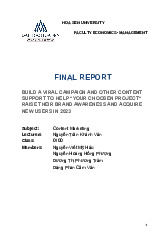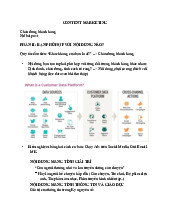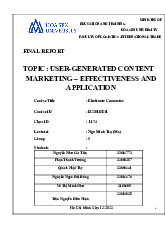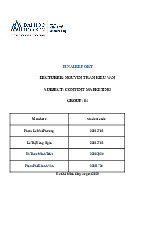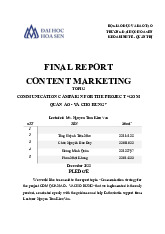






Preview text:
Dakouan, Chouaib; Benabdelouahed, Redouane; Anabir, Hajar Article
Inbound marketing vs. outbound marketing :
independent or complementary strategies
Provided in Cooperation with:
Expert journal of marketing
Reference: Dakouan, Chouaib/Benabdelouahed, Redouane et. al. (2019). Inbound marketing
vs. outbound marketing : independent or complementary strategies. In: Expert journal of marketing 7 (1), S. 1 - 6. This Version is available at:
http://hdl.handle.net/11159/4584 Kontakt/Contact
ZBW – Leibniz-Informationszentrum Wirtschaft/Leibniz Information Centre for Economics Düsternbrooker Weg 120 24105 Kiel (Germany) E-Mail: rights[at]zbw.eu
https://www.zbw.eu/econis-archiv/
Standard-Nutzungsbedingungen: Terms of use:
Dieses Dokument darf zu eigenen wissenschaftlichen Zwecken
This document may be saved and copied for your personal
und zum Privatgebrauch gespeichert und kopiert werden. Sie
and scholarly purposes. You are not to copy it for public or
dürfen dieses Dokument nicht für öffentliche oder kommerzielle
commercial purposes, to exhibit the document in public, to
Zwecke vervielfältigen, öffentlich ausstellen, aufführen, vertreiben
perform, distribute or otherwise use the document in public. If
oder anderweitig nutzen. Sofern für das Dokument eine Open-
the document is made available under a Creative Commons
Content-Lizenz verwendet wurde, so gelten abweichend von diesen
Licence you may exercise further usage rights as specified in
Nutzungsbedingungen die in der Lizenz gewährten Nutzungsrechte. the licence.
https://zbw.eu/econis-archiv/termsofuse
Expert Journal of Marketing, Volume 7, Issue 1, pp. 1-6, 2019
© 2019 The Authors. Published by Sprint Investify. ISSN 2344-6773 Marketing.ExpertJournals.com
Inbound Marketing vs. Outbound Marketing:
Independent or Complementary Strategies
Chouaib DAKOUAN*, Redouane BENABDELOUAHED, and Haja r ANABIR Hassan II University, Morocco
This article tends to explain the differences between the Outbound Marketing strategy
and the Inbound Marketing strategy, by offering a comparison of these techniques
used by these two approaches. This paper aims to determine the impact of the “new
marketing strategies” on the existent ones, and clarifies if these two strategies are
complementary or independent for a company operating in a highly competitive environment.
Keywords: Outbound Marketing, Inbound Marketing, Digital Marketing, Marketing Strategy, Online Marketing JEL Classification: M31 1. Introduction
The development of marketing strategy has undergone a valuable evolution, with the existence of the
digital communication and social networks, the content creation has been changed. Several years ago, the
companies were using the traditional strategy, as sending a message to an audience, in order to push them
towards their company or product, in opposite to the development of the new marketing strategies, namely
Inbound Marketing, a new way to pul the audience towards the company, by creating more innovative content.
The State of Inbound Marketing (Hubspot, 2013) describes Outbound Marketing or traditional
marketing as a technique used by firms in order to attract a large public, hoping to get a feedback. Using the
outbound strategy, mainly based on the diffusion of the message and publicity, without studying the target, in
order to receive an effective response and generate more sales and incomes.
Outbound marketing is interruption-based marketing, perceived as the traditional model of product
promotion in which people have to stop what they are doing to pay attention to the marketing message or deal
with it in some other way (Rancati et al., 2015). Outbound marketing is also a strategy in which a business
advertises its products and services by presenting information to consumers even if they are not looking for
those products or services (Goodwin, 2013). However, this strategy is no longer effective in getting the
message across and making traffic in the web world, that is why companies, nowadays, tend to explore new
strategies such as Inbound Marketing approach in order to get more results from the internet.
In the first second section of this paper, we wil define inbound marketing and get an overview of the * Corresponding Author:
Chouaib Dakouan, Hassan II University, Faculty of Legal, Economical and Socials Sciences, 2634 Route des Chaux et Ciments, Casablanca, Morocc o Article History:
Received 02 November 2018 | Accepted 3 January 2019 | Available Online 29 January 2019 Cite Reference:
Dakouan, C. and Benabdelouahed, R. and Anabir, H., 2018. Inbound Marketing vs. Outbound Marketing: Independent or Complementary Strategies.
Expert Journal of Marketing, 7(1), pp.1-6.
Dakouan, C. and Benabdelouahed, R
. and Anabir, H., 2018. Inbound Marketing vs. Outbound Marketing: Independent or Complementary Strategies.
Expert Journal of Marketing, 7(1), pp.1-6.
emergence of this concept. In the third section, we wil explain the components of inbound marketing. In fourth
section, we wil compare Outbound and Inbound Marketing in order to know if they represent independent or complementary strategies.
2. Definitions of Inbound Marketing
Inbound marketing is the strategy of connecting with potential customers through materials and
experiences they find useful. Using media like blogs and social networking, marketers hope to entertain and
inform viewers with content they seek by themselves (Marketing-Schools.org, 2016).
On other hand, inbound marketing can be explained as a form of marketing that requires a very careful
targeting of the audience and a custom communication via high quality content (Patrutiu-Baltes, 2016).
Moreover, Venisse (2016) defined inbound marketing as a way to become its own media in order for
the audience to convert more easily into customers. The implementation of the global inbound marketing
strategy requires the respect of certain essential steps (Venisse, 2016). The first step is to develop its own
media and build a qualified audience. For a company that sets up this strategy, it is important to offer interesting
content on its site, its blog or its social network page, to attract and sustain an audience.
Also, Schwebel (2017) suggests that inbound marketing has the potential to develop a brand to become
its own medium, that is to say, to offer content that is intel igent and relevant enough to build an audience,
instead of intrusive ads (Dabi-Schwebel, 2017).
Cantin (2014) defines inbound marketing is a digital marketing strategy aimed at bringing the
customer to the company rather than picking him up. The prospect is attracted by relevant content positioned
according to phases of maturity of purchases and levels of commitment. Therefore, in this line of thoughts, we
could also talk about the acquisition marketing (Cantin, 2014). We define inbound marketing also as a digital
marketing strategy whose general idea is to continuously attract potential prospects with quality content. To
do this, Inbound Marketing uses a four-step methodology: Attract, Convert, Transform, and Retain
(InboundValue.com, 2018). Moreover, as Rouse (2014) proposed, inbound marketing can be defined “as a
technique that focuses on bringing consumers or leads via relevant content, so that consumers search for the
company instead of the opposite. The concept of inbound marketing make tasks easier for the consumers who
want relevant goods, products or services” (Rouse, 2014).
Hubspot (2018) defines Inbound Marketing as a strategy that attracts customers with relevant and
useful content and adds value at every step of the customer-shopping journey. With inbound marketing,
potential customers find their way through channels such as blogs, search engines and social media (Hubspot,
2016). Unlike Outbound Marketing, Inbound Marketing does not need to fight for the attention of potential
customers. By creating content that addresse
s the issues and needs of ideal customers, the brand attracts
qualified prospects and builds trust and credibility. Hence, inbound marketing is a systemic approach that
al ows each brand to become its own media, create an audience and convert it into prospects and then
customers. A whole process works wel on the details while eliminating any failure (Dabi-Schwebel, 2017).
3. Emergence of the Inbound Marketing
The term « Inbound » was used by Brian Hal igan (Hal igan et al., 2009). The term inbound refers to
attracting and convert individuals to lasting customers.
Corresponding to the creators of inbound marketing Brian Hal igan and Dhamesh Shah, the needs for
this innovative concept was created from the fact that people are sick and tired of being interrupted with
traditional outbound marketing messages. Moreover, the marketing tactics used successfully in the past didn’t
produce the desire results anymore (Hal igan et al., 2009).
It al started when Shah started a blog on startups and entrepreneurship, then, he noticed that his blog
gained a massive traffic more than websites owned by companies with professional marketing crews and big
budgets. After a lot of analysis and discussions, they came out with a simple observation that “People did not
want to be interrupted by marketers or harassed by salespeople, they want to be helped” (Halligan and Shah,
2014). The main idea of inbound marketing is using marketing techniques that wil try to pick up the interest
of customers, by sharing creative and useful content that it is shared through multiple online channels,
including search engines and social media.
Even if inbound marketing was first introduced in 2005 by Hal igan and Shah, it is actual y not a new
concept, it is similar to the marketing method named “Content marketing” an it can also be associated to
“Storytelling marketing”, namely a technique used way before the emergence of the internet (Pulizzi, 2012). 2
Dakouan, C. and Benabdelouahed, R
. and Anabir, H., 2018. Inbound Marketing vs. Outbound Marketing: Independent or Complementary Strategies.
Expert Journal of Marketing, 7(1), pp.1-6.
Moreover, content marketing is defined as marketing process that aims to develop relevant content in
order to attract and engage a target audience, thus, getting a profitable consumer action (Pulizzi, 2012).
Also, content marketing must include strategic planning, content creation and distribution for multiple
stages of the buying cycle to multiple customers, means that a complete content marketing strategy should
incorporate the Inbound marketing principle (Pulizzi, 2011).
One of the inbound marketing’s techniques known as the search engine optimization (SEO) was
practiced for a long time before the concept of content marketing, and SEO is mostly used to increase the
number of visitors that come from search engines.
The keywords were considered the most important element to achieve high ranking, then, with time
and after the introduction of many updates that were included, such as Panda in 2011, Penguin in 2012 and the
Hummingbird update in 2013 (Wainwright, 2014), this importance of keywords decreased. Also, because of
these updates, SEO becomes a very difficult task. From here, inbound marketing comes in place, according to
Rand Fishkin, SEO is a tactic, and inbound marketing is a strategy.
Email marketing also refers to one of the important elements of inbound marketing based on sending
newsletter, articles or others, via an e-mail. It is a type of marketing based on the permission given by the
visitors, is it also known as permission marketing, namely a concept that was developed by Seth Godin (Godin, 1999).
4. Components of Inbound Marketing 4.1. Content Marketing
Although content marketing has remained in the shadow of traditional marketing given the lack of
technology at that time, it has managed today to establish itself as an effective strategy especial y with the rise of new technologies.
Chaffey and Al (2000) define content as a text and graphic information design that forms a web page.
Good content is a keystone to attract customers to a website and retain their interest while provoking repeat
visits. Content marketing can also be the company's intranet content or the company's internet content,
including databases and various types of knowledge (Chaffey and Al, 2000).
For their part, Pulizzi and Barret (2009) also define content marketing as a marketing technique that
consists of creating, publishing and distributing relevant, useful and valuable content to get profits from the
consumers. Content marketing tends to have media rather than renting it. It is defined as a marketing process
that attracts and retains customers by constantly creating content that aims to change or evolve consumer
behavior (Pulizzi, J. and Barrett, 2009).
Handley and Chapman (2010) argue that content marketing is al that an individual or organization
creates or shares to tel their stories. The content is conversational, human and does not constantly seek to sel .
It must be a state of mind that is both timid and encouraged (Handley and Chapman, 2010).
Gunelius (2011) defines content marketing as a process of direct and indirect promotion of a company
or brand through the benefit of a text, video or audio content at a time, in online and offline environments. It
can appear in long-form (blogs, articles, e-books and sound), in short-form (Twitter, Facebook, images ...), or
in conventional form, (content sharing via Twitter or participate in an active discussion via comments on blog
posts or through online forums) (Gunelius, 2011).
Staler (2014) explains that content marketing is a dynamic technique aimed at attracting customers, it
is a process of sharing expertise and knowledge in order to attract potential customers and establish a
relationship with them (Slater, 2014).
Ramos (2014) defines content marketing as a high-quality marketing technique, relevant content that
aims to be educational and mobilizing to acquire the target audience (Ramos, 2014).
Kotler et al. (2017) define content marketing as a marketing approach that consists of creating,
organizing, distributing and amplifying interesting, relevant and useful content for a clearly defined audience
group to create content conversations. Content marketing is also another form of branding and branded
journalism that creates closer links between brands and customers. Ultimately, content marketing is about
planning, creating, promoting, and monitoring performance for a targeted audience, always with the goal of
customer satisfaction and revenue generation in mind (Kotler et al., 2017). 4.2. Social Media Marketing
The characteristics of social media and their immense popularity have revolutionized commercial
practices such as advertising and promotion. 3
Dakouan, C. and Benabdelouahed, R
. and Anabir, H., 2018. Inbound Marketing vs. Outbound Marketing: Independent or Complementary Strategies.
Expert Journal of Marketing, 7(1), pp.1-6.
Social networks are original spaces. They can give rise to conventional top-down communication
companions (one to many), but also change this vertical and unilateral communication towards a dialogue
between the user and the brand (one to one) or even more between the Internet users themselves same (man to many).
However, consumers are less and less interested in traditional advertising, which puts enormous
pressure on marketers. The chal enge lies in spreading complex information through messages without
overwhelming consumers. The attitude of today's consumers has changed profoundly, the time of appreciation
and reading of message has diminished a lot. The average attention span of humans has decreased from 12
seconds in 2000 to 8 seconds in 2013. Even more, this attention is destined to diminish in the future, because
of the massive and overwhelming volume of messages constantly bombarding connected mobile devices that
require immediate consumer attention (Kotler et al., 2017).
Social networks have played a very important role in these changes. In the past, consumers were
limited to commercials generated on traditional media because they did not have much choice. Today, with
the advent of social networks, consumers have a wealth of content generated by businesses or even by other
consumers that they find more credible and interesting. The idea is that content that is shared on social
networks is voluntary and accessible on demand, unlike content that was shared on traditional media whose character is imposed.
At the social media level, consumers can now choose which content they discover and enjoy. Ads can
no longer stop viewers, as it is the example of YouTube ads (True View), which precede videos, consumers
can now ignore these ads after five seconds. If brands or advertisers fail to attract attention in the first five
seconds, they cannot complain that consumers choose to ignore the rest of their content (Kotler et al., 2017).
The use of social networks, especial y via content marketing strategies, has become very useful in the
marketing approach of brands, first by approaching Internet customers of their brands favorably thanks to
direct and immediate contact. Then, they give brands the sense of innovation and taste of advertising, without
spending too much money. Final y, social networks al ow brands to benefit from word of mouth through the
interconnections between their members. Brands must be very attentive and listen to advice, comments and
publications left by users on the page of the brand.
Unfortunately, companies often transfer their content to social media without modifying it,
considering that content is just a longer version of an advertisement. However, there is a clear difference
between these two modes of communication, advertising represents the message the brand wants to convey to
consumers. While content marketing disseminates the information that consumers wil use to achieve their
personal and professional goals (Kotler et al., 2017).
In order to ensure optimal consumer involvement, companies must take advantage of social media by
creating content that, even if it does not contribute to the sale and promotion of the brand, the brand wil
become essential for consumers.
4.3. Search Engine Optimization
A SEO marketing logic (Search Engine Optimization) is based on the assumption that the organic
traffic (free traffic, without advertising on media) of a site depends on the quality of its natural referencing, so
that search engines (including, first and foremost, the unmatched Google) can locate it and especial y list it correctly (Sauvage, 2016).
To do this, powerful algorithms locate the domain name (another name for the website) and analyze
the content. They identify linking such as internal and external links and URL sources, and estimate the quality
of each page on the topic chosen. This assumes that the website is properly structured at the base so that the
bots can easily go from one page to another (Sauvage, 2016).
That is why having a content strategy is relevant from an SEO point of view: it simply gives more
chances to tel Google "here's what I'm talking about, and here's my site with the most relevant pages for each subject".
The precise recipe for each of these algorithms which are more than 200, according to the Mountain
View firm remains a jealously guarded secret. However, over time, SEO has been better understood by
marketers, and so it has been partial y debunked.
5. Inbound Marketing vs. Outbound Marketing
Outbound marketing is interruption based marketing, perceived as the traditional model of product
promotion in which people have to stop what they are doing to pay attention to the marketing message or deal
with it in some other way (Rancati et al., 2015). 4
Dakouan, C. and Benabdelouahed, R
. and Anabir, H., 2018. Inbound Marketing vs. Outbound Marketing: Independent or Complementary Strategies.
Expert Journal of Marketing, 7(1), pp.1-6.
The difference between inbound and outbound marketing is constantly chal enged. Inbound marketing
has now experienced growth compared to outbound marketing which is declining. In addition, the investments
in the channels of inbound marketing has come to increase significantly, compared to other channels of
outbound marketing that are now either stagnant or are experiencing slow growth (Volpe, 2015).
Volpe (2015) suggests that the difference between the incoming and the outgoing is artificial and
meaningless. Moreover, he proposes a cross between the strategies of the incoming and outgoing marketing,
defined as a gray zone (Volpe, 2015).
Table 1. Inbound and Outbound Marketing Comparison Outbound Marketing Inbound Marketing Grey Zone Print Ads Content Marketing E-mail Marketing Direct Mailings Blog Marketing Display Advertising Outbound Cal Center SEO Search Engine Ads TV, Radio advertising Social Media Marketing Social media (when used a Intrusive online ads Viral Marketing broadcasting medium) Podcasts RSS
Source: adapted from Volpe (2015) and Rancati et al. (2015)
“Inbound Marketing creates Top of Mind Preference, while Outbound Marketing is mainly focused
on Top of Mind Awareness. With inbound content marketing programs, you can move beyond simple
awareness to generate preference and implicitly brand addiction, this goal can be achieved through the
positioning of a brand as the preferred choice” (Martin, 2013; Rancati et al., 2015).
Inbound Marketing’s great chal enge is to get the consumer to find the company online, because of
the highly competitive keyword space. The timeframe in which a company is waiting for consumers to find it
online might result in a sale loss (Rancati et al., 2015).
6. Conclusion and Future Research
One of the great advantages of the internet is that it reaches consumers around the world, the
globalization of business promises a lot thanks to the advent of new technologies.
The inbound marketing is a strategy that aims to attract prospects to a company’s website, convert
them to leads and then further, to lifelong customers and brand promoters.
In this article, we have proposed a comparison between Inbound and Outbound Marketing strategies.
That said, based on this paper’s propositions, we conclude that both Inbound and Outbound strategies are
complementary for the success of any viable marketing campaign. Both strategies have their pros and they can
both be used together, often to a greate r effect, creating a synergy.
Indeed, the mix of outbound and inbound marketing strategies can work most effectively and reach
the most amount of people when done hand-in-hand
Nevertheless, Inbound Marketing is primarily content marketing and its efficiency is superior to the
Outbound Marketing efficiency because inbound aims to identify the target customers and adapt the
communication, however it allows a better targeting of the audience and a better adaptation of the company’s communication mechanisms. 6.1. Future Research
This theoretical article can be extended to encompass an empirical study that calculates through
different metrics the impact of inbound marketing practices on consumers, via data gathered from websites such as www.Alexa.com. References Cantin, 2014. Inbound marketing definition. [online] Available at:
https://www.mychefcom.com/blog/definition-de-linbound-marketing [Accessed 05 May 2018].
Chaffey, D., Mayer, R., Johnston, K. and El is-Chadwick, F., 2000. Internet marketing. Edinburgh: Pearson Education.
Dabi-Schwebel, G., 2017. L'inbound marketing permet de convertir son audience en clients [online] Available
at: http://www.entreprendre.fr/gabriel-dabi-schwebel [Accessed 05 May 2018]. 5
Dakouan, C. and Benabdelouahed, R
. and Anabir, H., 2018. Inbound Marketing vs. Outbound Marketing: Independent or Complementary Strategies.
Expert Journal of Marketing, 7(1), pp.1-6.
Godin, S., 1999. Permission marketing. NY, USA : Simon & Schuster.
Goodwin, T., 2013. Inbound marketing vs. outbound marketing: what’s the difference?. [online] Available at:
http://boldthinkcreative.com/inbound-marketing-vs-outbound-marketing-whats-the-difference/ [Accessed 04 May 2018].
Gunelius, S., 2011. Content Marketing for Dummies. NY, USA: Wiley.
Hal igan, B. and Shah, D., 2014. Inbound marketing - Attract, Engage and delight customers online. New Jersey, USA :Wiley
Hal igan, B. and Shah, D., Meerman Scott, D., 2009. Inbound Marketing: Get Found Using Google, Social
Media, and Blogs. New Jersey, USA :Wiley.
Handley, A. and Chapman, C.C., 2010. Content Rules. NY, USA: Wiley.
Hubspot, 2016. The Inbound Methodology - The best way to turn strangers into customers and promoters of
your business. [online] Available at: http://www.hubspot.com/inbound-marketing>. [Accessed 05 May 2018]. InboundValue.com, 2018. What is Inbound Marketing? [online] Available at:
https://www.inboundvalue.com/definition-inbound-marketing/ [Accessed 05 May 2018].
Keyes, J., 2006. Knowledge management, business intel igence and content management. NY, USA: Auerbach Publications.
Kotler, P., Kartajaya, H. and Setiawan, I., 2017. Marketing 4.0: Moving from Traditional to Digital, NY, USA: Wiley., 2017.
Marketing-Schools.org, 2016. Inbound Marketing - Explore the Strategy of Inbound Marketing. [online] Available at:
http://www.marketing-schools.org/typesof-Marketing/inbound-marketing.html [Accessed 05 May 2018].
Martin, T., 2013, Inbound Marketing versus Outbound Marketing Compared [online] Available at:
http://www.conversedigital.com/social-sel ing-posts/inbound-marketing-versus-outbound-
marketing-salesprospecting [Accessed 11 November 2018].
Patrutiu-Baltes, L., 2016. Inbound Marketing - the most important digital marketing strategy. Bul etin of the
Transilvania University of Braşov, Series V: Economic Sciences, Vol. 9 (58), No. 2, pp.61-68.
Pulizzi, J. and Barrett, N., 2009. Get content. Get customers. NY, USA: McGraw Hil .
Pulizzi, J., 2012. The Rise of Storytel ing as the New Marketing. Publishing Research Quarterly, 28(2), pp. 116-123.
Pul izi, J., 2011. The 7 Business Goals of Content Marketing: Inbound Marketing Isn’t Enough [online]
Available at: https://contentmarketinginstitute.com/2011/11/content-marketing-inbound-marketing/ [Accessed 05 May 2018].
Ramos, R., 2014. Content Marketing: insider’s secret to online sales and lead generation. NY, USA: One Night Expert Publishing.
Rancati, E., Codignola, F. and Capatina, A. 2015. Inbound And Outbound Marketing Techniques: A
Comparison Between Italian And Romanian Pure Players And Click And Mortar Companies.
International Conference "Risk In Contemporary Economy" Xvith Edition, 2015, Galati, Romania. Rouse, M., 2014. What is inbound marketing. [online] Available at:
https://www.techtarget.com/contributor/Margaret-Rouse [Accessed 05 May 2018].
Sauvage, M., 2016. Pourquoi SEO et inbound marketing vont-ils bien ensemble? [online] Available at:
https://www.inboundvalue.com/blog/pourquoi-seo-v -
s inbound-marketing. [Accessed 11 November 2018].
Slater, D., 2014. Content marketing: recycling and reuse. New York: i30 Media Corporation.
Venisse, M., 2016. Créer sa stratégie inbound marketing globale [online] Available at:
https://www.1min30.com/formations-e-learning/strategie-inbound-marketing-1287455005 [Accessed 04 May 2018].
Volpe, M., 2015. Inbound marketing versus outbound marketing: a pointless debate [online] Available at:
https://www.i-scoop.eu/inbound-marketing-versus-outbound-marketing-pointless-debate/. [Accessed 11 November 2018]. Wainwright, C., 2014. Confessions of a Content Marketer. [online] Available at:
https://blog.hubspot.com/blog/tabid/6307/bid/28681/confessions-of-a-content-marketer.aspx >. [Accessed 11 November 2018]. 6
